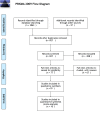The Advancement in Detecting Sepsis and Its Outcome: Usefulness of Procalcitonin in Diagnosing Sepsis and Predicting Fatal Outcomes in Patients Admitted to Intensive Care Unit
- PMID: 33996303
- PMCID: PMC8114960
- DOI: 10.7759/cureus.14439
The Advancement in Detecting Sepsis and Its Outcome: Usefulness of Procalcitonin in Diagnosing Sepsis and Predicting Fatal Outcomes in Patients Admitted to Intensive Care Unit
Abstract
Sepsis still remains a big challenge in patients admitted to intensive care units (ICUs) despite stellar advances made in the field of medicine. We can achieve better clinical outcomes in patients by diagnosing sepsis earlier. Procalcitonin (PCT), an inflammatory biomarker, has shown promising results in this regard. Therefore, this systematic review was done to assess the use of PCT in diagnosing and predicting severe outcomes in patients admitted to ICU and to assess if introducing PCT as a routine biochemical tool in hospitals would be helpful to achieve better clinical course in ICU patients. To identify relevant articles, we searched PubMed, Google Scholar, and references of included articles. Eligible studies were identified by two investigators independently and data were extracted. Original articles that evaluated the diagnostic and prognostic value of serum PCT levels in predicting sepsis, the severity of sepsis, and mortality among adult patients admitted to ICU were included in this study. A total of 2,063 citations were identified by the search, among which 10 studies (five prospective cohort, three retrospective cohort, one cross-sectional, and one case-control study) met the inclusion criteria. Most studies showed moderate-to-low risk of bias which was evaluated using the Quality in Prognosis Studies tool. All studies showed a positive correlation between initial PCT levels and detecting mortality resulting from sepsis, six studies found PCT helpful in detecting sepsis, and four studies evaluated the role of PCT in detecting severity in patients with sepsis. One study found area under the curve of serum PCT level for predicting 28-day mortality to be 0.82 (95% confidence interval [CI]: 0.70-0.94; p < 0.001) in adults and 0.83 (95% CI: 0.73-0.92; p < 0.001) in the elderly having an optimal cut-off level of serum PCT of 0.2 ng/mL in both the adult and elderly groups, with a sensitivity of 81 and 75% and specificity of 81.7 and 80.4%, respectively. PCT has shown promising results in detecting sepsis and its clinical course. For early diagnosis and management of sepsis, severe sepsis, and mortality in patients admitted to the ICU for a more favorable clinical outcome, PCT can be used.
Keywords: diagnosis & prognosis; inflammatory biomarker; procalcitonin; sepsis; sirs.
Copyright © 2021, Malik et al.
Conflict of interest statement
The authors have declared that no competing interests exist.
Figures




Similar articles
-
The efficacy of procalcitonin as a biomarker in the management of sepsis: slaying dragons or tilting at windmills?Surg Infect (Larchmt). 2013 Dec;14(6):489-511. doi: 10.1089/sur.2012.028. Epub 2013 Nov 25. Surg Infect (Larchmt). 2013. PMID: 24274059 Review.
-
The prognostic value of serum procalcitonin measurements in critically injured patients: a systematic review.Crit Care. 2019 Dec 3;23(1):390. doi: 10.1186/s13054-019-2669-1. Crit Care. 2019. PMID: 31796098 Free PMC article.
-
[Diagnostic and prognostic value of neutrophil CD64, IL-6, and PCT in ICU patients with sepsis].Zhonghua Wei Zhong Bing Ji Jiu Yi Xue. 2023 May;35(5):463-468. doi: 10.3760/cma.j.cn121430-20230112-00021. Zhonghua Wei Zhong Bing Ji Jiu Yi Xue. 2023. PMID: 37308224 Chinese.
-
[Clinical value of serum endocan and procalcitonin in early diagnosis and prognosis evaluation of sepsis].Zhonghua Wei Zhong Bing Ji Jiu Yi Xue. 2017 Apr;29(4):321-326. doi: 10.3760/cma.j.issn.2095-4352.2017.04.007. Zhonghua Wei Zhong Bing Ji Jiu Yi Xue. 2017. PMID: 28420465 Chinese.
-
[Prognostic value of Charlson weighted index of comorbidities combined with sequential organ failure assessment score and procalcitonin in patients with sepsis].Zhonghua Wei Zhong Bing Ji Jiu Yi Xue. 2019 Nov;31(11):1335-1339. doi: 10.3760/cma.j.issn.2095-4352.2019.11.005. Zhonghua Wei Zhong Bing Ji Jiu Yi Xue. 2019. PMID: 31898562 Chinese.
Cited by
-
A Clinical and Demographic Profile of Elderly (>65 Years) in the Medical Intensive Care Units of a Tertiary Care Center.Indian J Crit Care Med. 2023 Mar;27(3):166-175. doi: 10.5005/jp-journals-10071-24416. Indian J Crit Care Med. 2023. PMID: 36960107 Free PMC article.
-
The Role of Procalcitonin/Albumin Ratio and CRP/Albumin Ratio in Predicting In-hospital Mortality in COVID-19 Patients.J Acute Med. 2023 Dec;13(4):150-158. doi: 10.6705/j.jacme.202312_13(4).0003. J Acute Med. 2023. PMID: 38099207 Free PMC article.
-
Comparison of Two Predictive Models of Sepsis in Critically Ill Patients Based on the Combined Use of Inflammatory Markers.Int J Gen Med. 2022 Feb 2;15:1013-1022. doi: 10.2147/IJGM.S348797. eCollection 2022. Int J Gen Med. 2022. PMID: 35140504 Free PMC article.
-
The Value of a Complete Blood Count (CBC) for Sepsis Diagnosis and Prognosis.Diagnostics (Basel). 2021 Oct 12;11(10):1881. doi: 10.3390/diagnostics11101881. Diagnostics (Basel). 2021. PMID: 34679578 Free PMC article. Review.
References
-
- Definitions for sepsis and organ failure and guidelines for the use of innovative therapies in sepsis. The ACCP/SCCM Consensus Conference Committee. American College of Chest Physicians/Society of Critical Care Medicine. Bone RC, Balk RA, Cerra FB, et al. Chest. 1992;101:1644–1655. - PubMed
-
- 2001 SCCM/ESICM/ACCP/ATS/SIS International Sepsis Definitions Conference. Levy MM, Fink MP, Marshall JC, et al. https://pubmed.ncbi.nlm.nih.gov/12682500/ Crit Care Med. 2003;31:1250–1256. - PubMed
-
- New developments in the diagnosis of bloodstream infections. Peters RP, van Agtmael MA, Danner SA, Savelkoul PH, Vandenbroucke-Grauls CM. Lancet Infect Dis. 2004;4:751–760. - PubMed
-
- Pathobiochemistry and clinical use of procalcitonin. Meisner M. Clin Chim Acta. 2002;323:17–29. - PubMed
-
- Procalcitonin assay in systemic inflammation, infection, and sepsis: clinical utility and limitations. Becker KL, Snider R, Nylen ES. Crit Care Med. 2008;36:941–952. - PubMed
Publication types
LinkOut - more resources
Full Text Sources
Other Literature Sources
Miscellaneous
